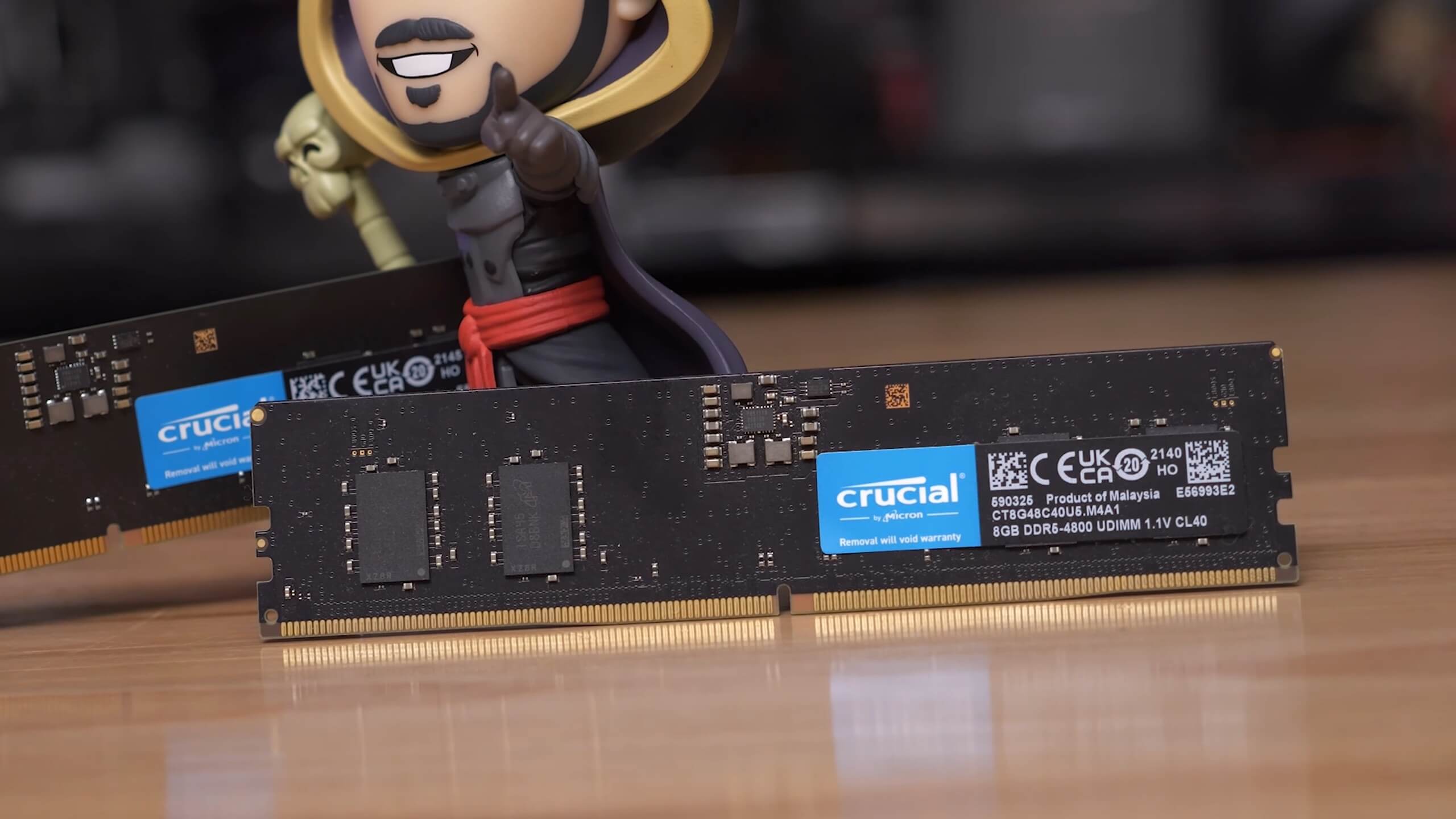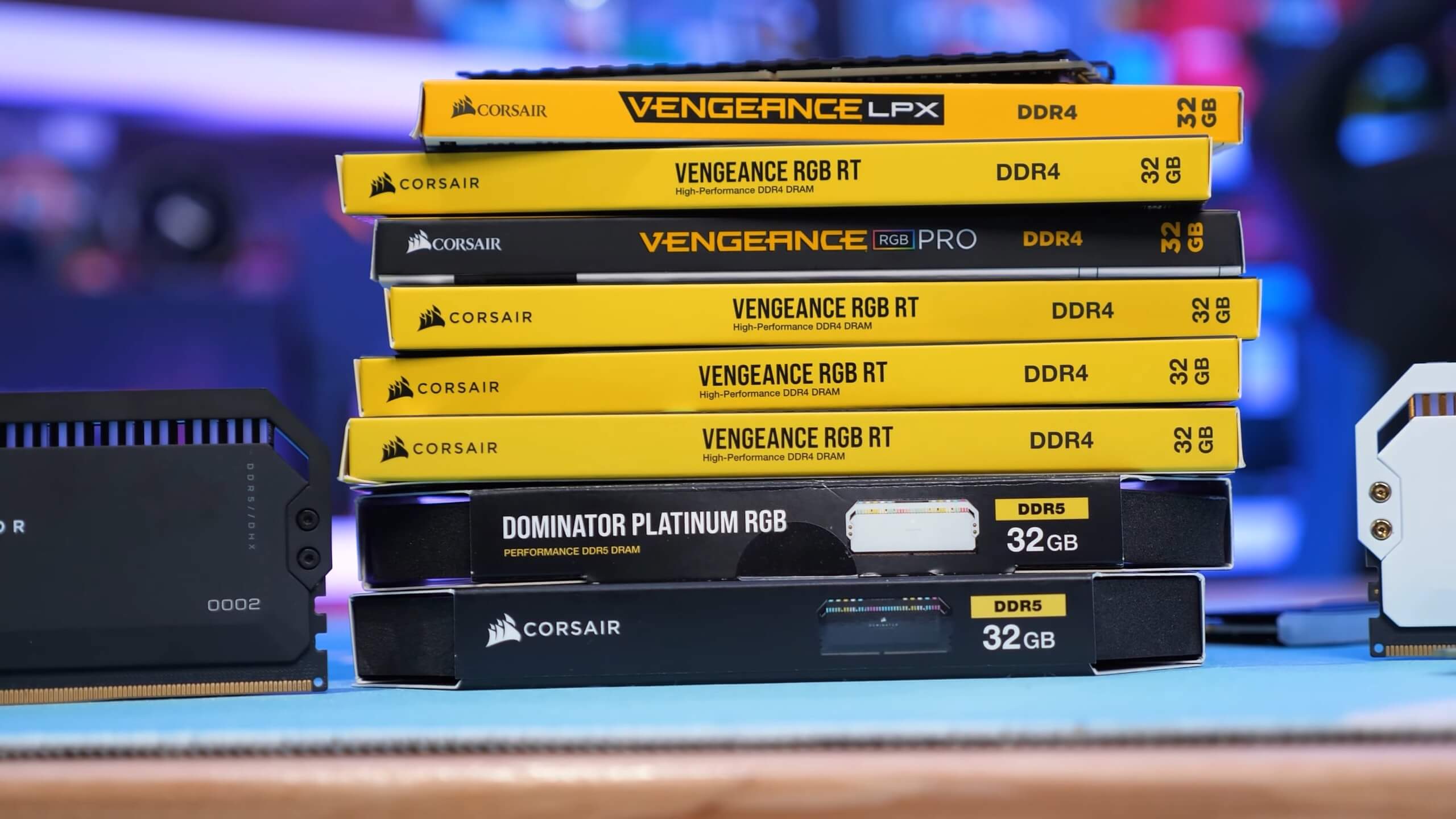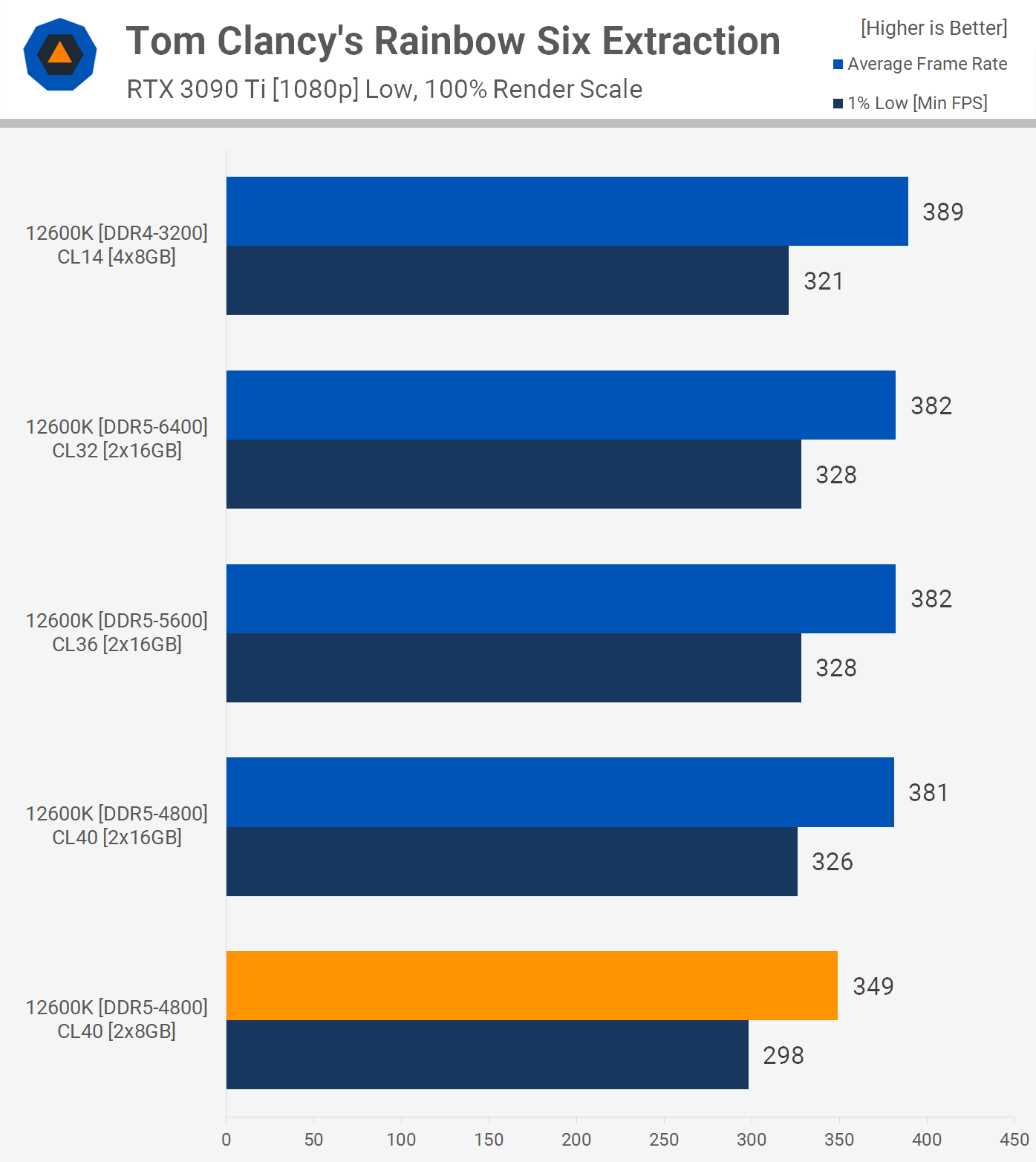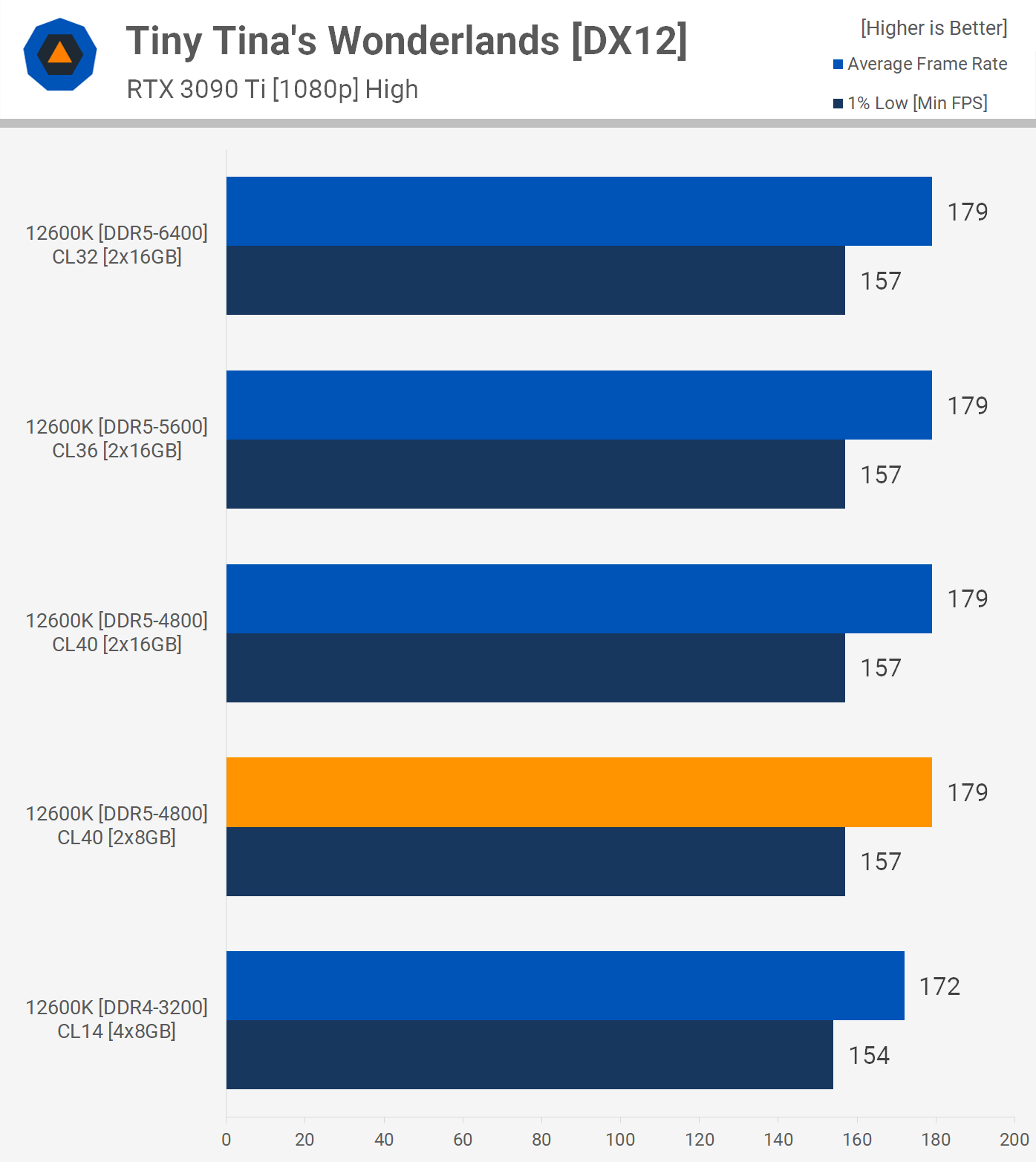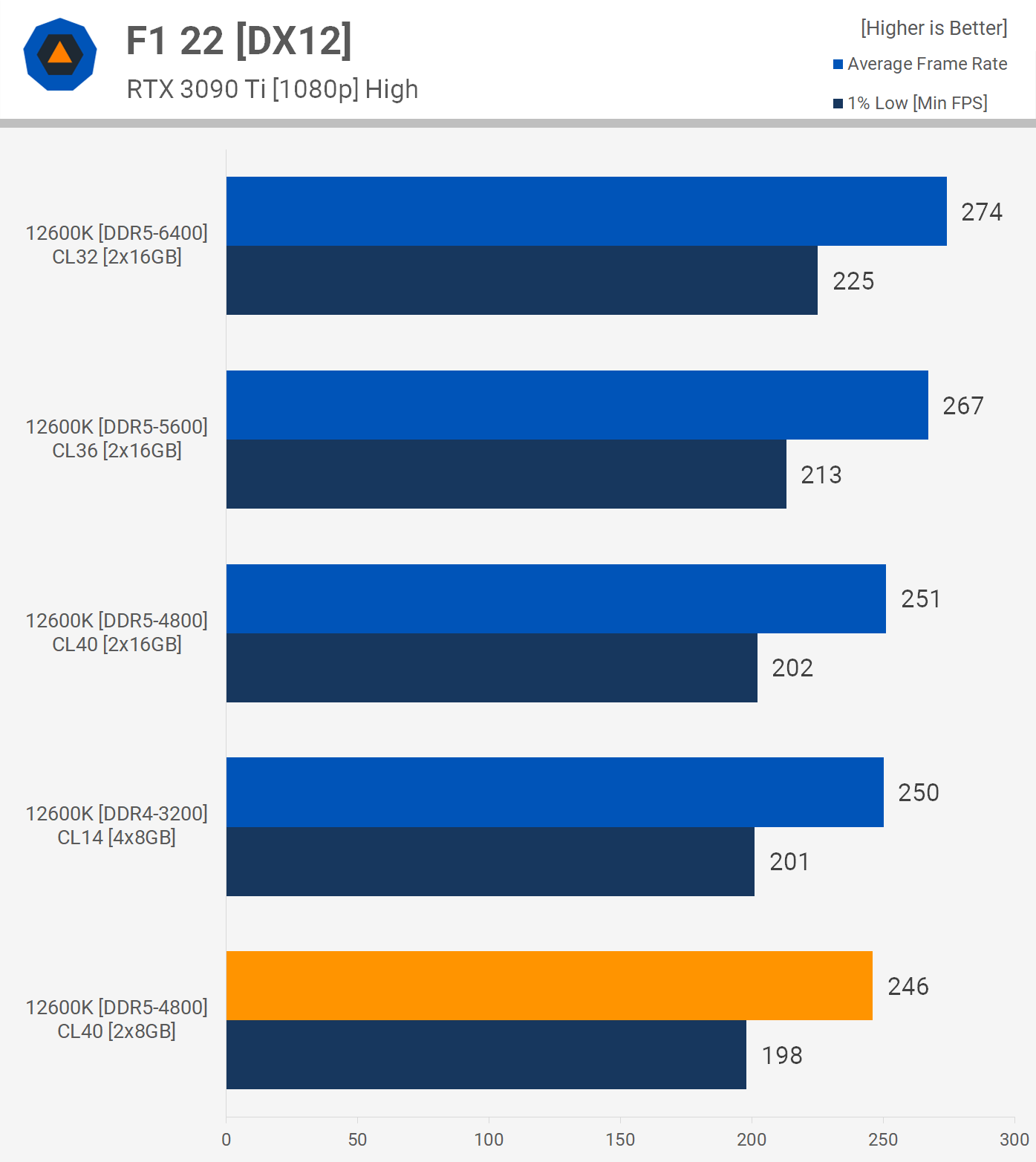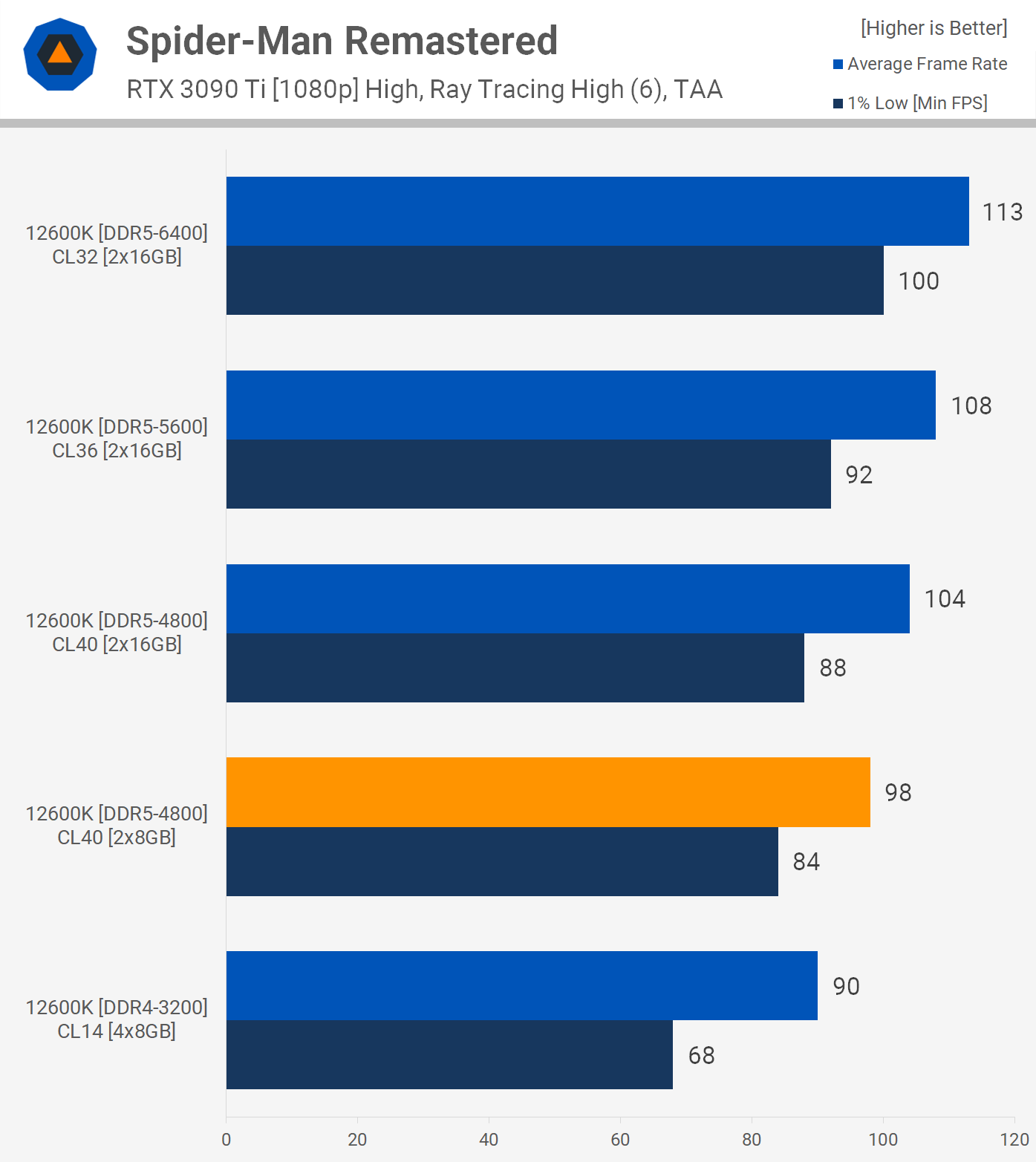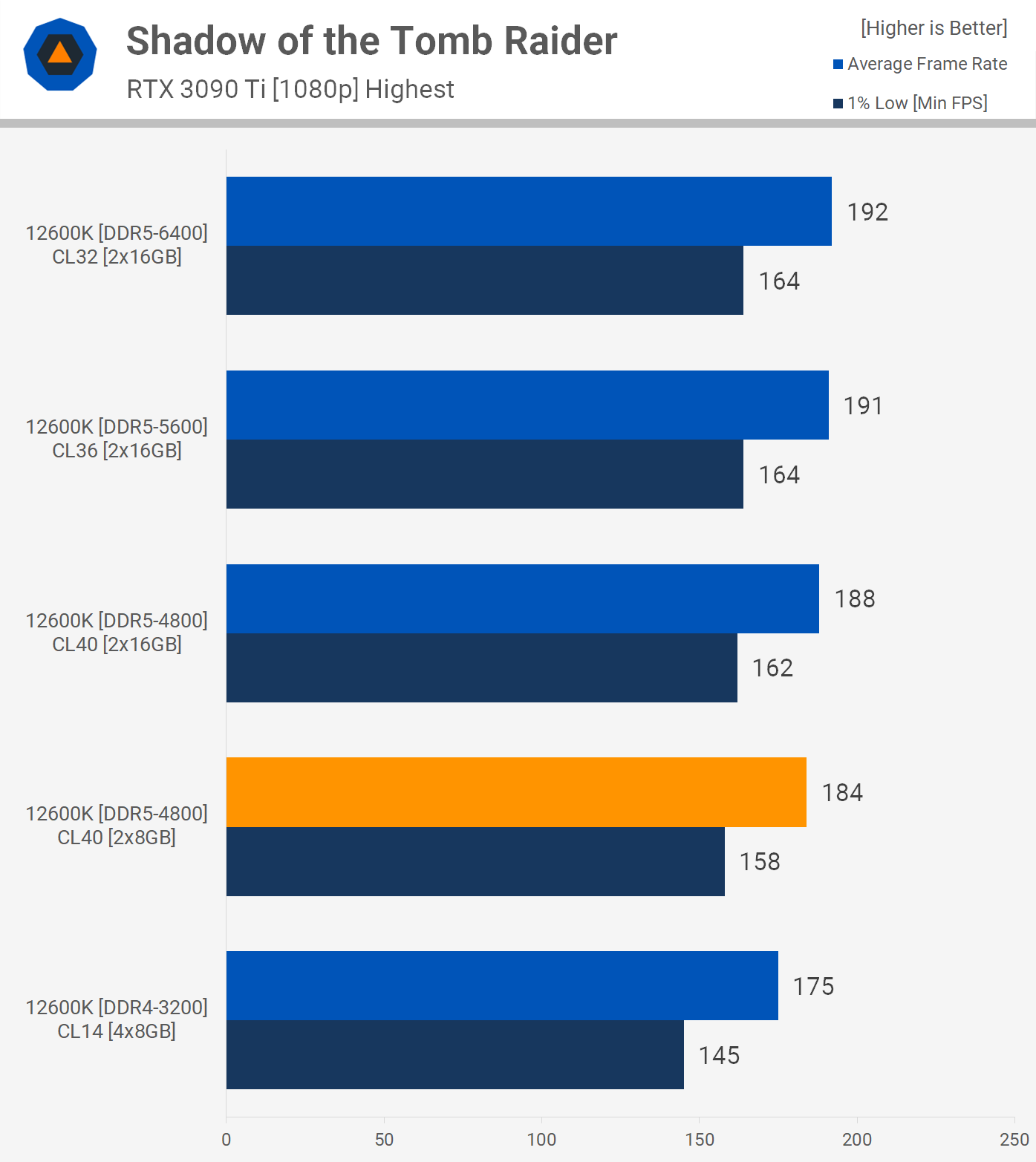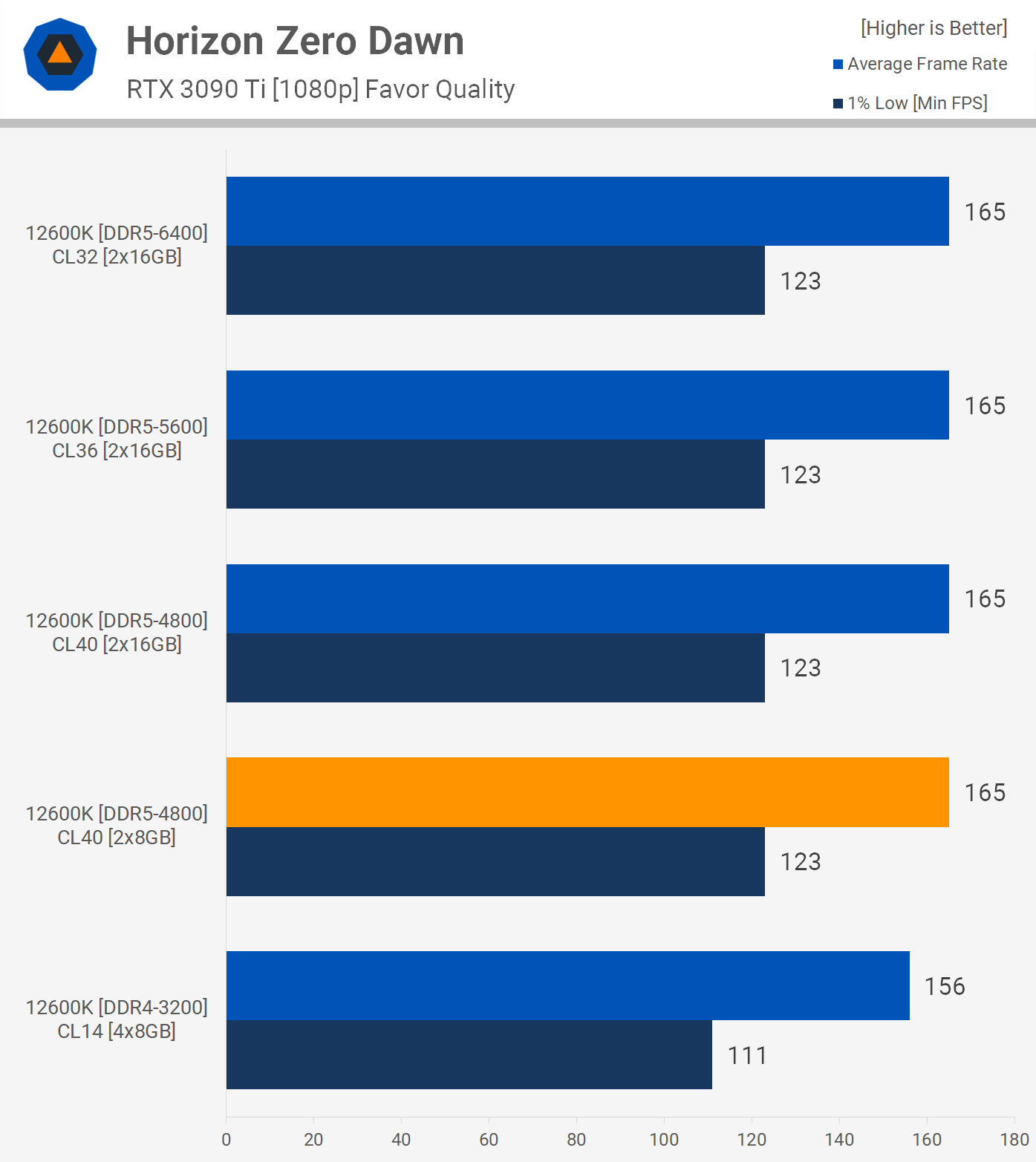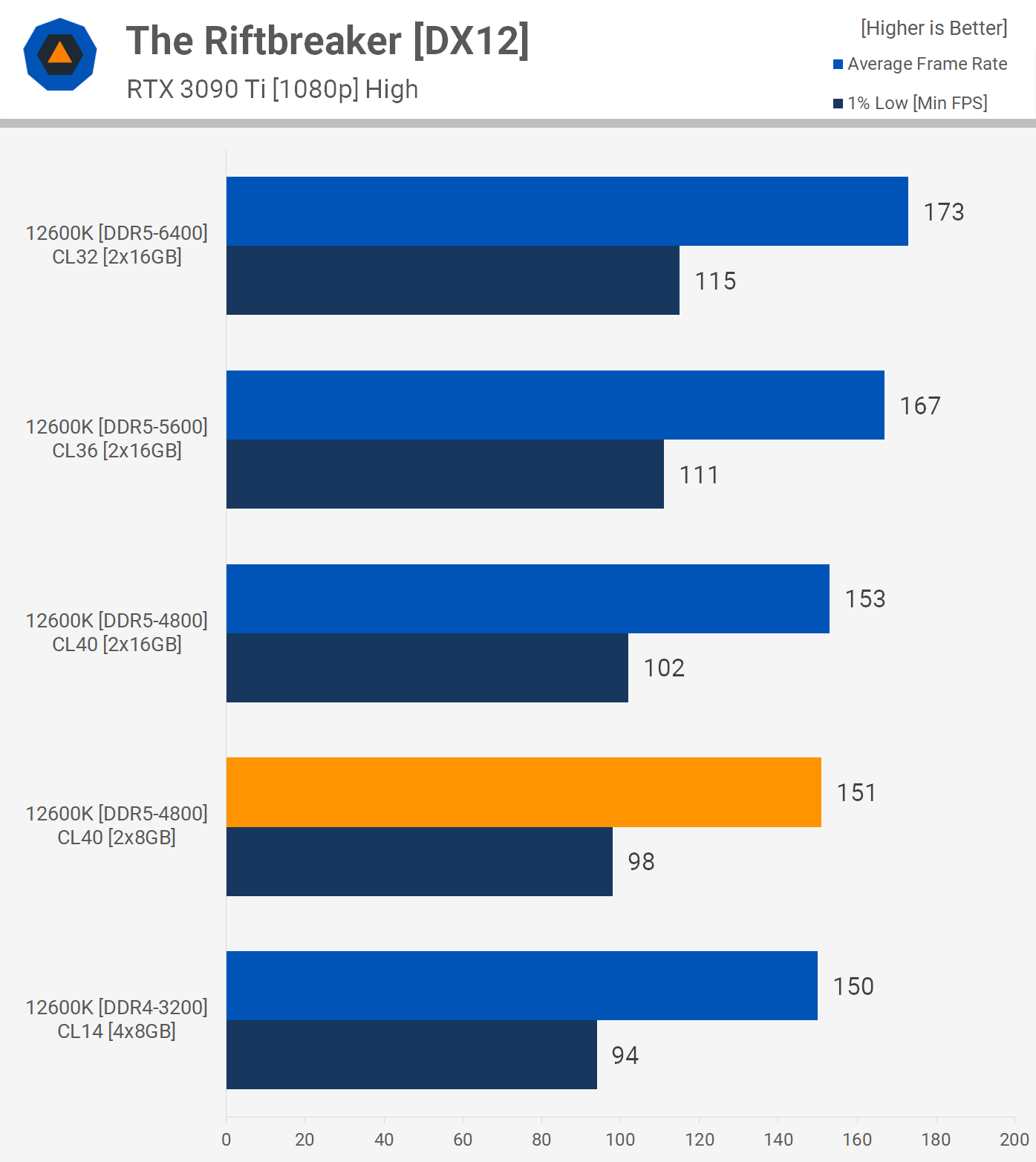For this article we're doing something simple: find the cheapest DDR5 RAM we could get our hands on, in this case Crucial's 8GB 4800 CL40 modules which cost ~$44 for each module, so $88 for two giving us a 16GB capacity, which for most games is still ample.
When compared to basic DDR4 memory, that's still expensive at around twice the price of DDR4-2666, but the DDR5 memory is much faster. The question is, how does it compare to premium DDR4 memory like the dual-rank CL14 3200 stuff we often use for benchmark testing, which costs around $50 per module, or $70 if you opt for 3600 memory.
Sweet-spot DDR4-3600 CL16 memory costs around $35 per 8GB module, which makes the $44 for DDR5-4800 not a crazy premium, assuming we're looking at comparable performance. It also means DDR5 is now approaching a point where you'd start to consider it for new Intel Alder Lake builds as well as the upcoming 13th-gen Raptor Lake CPUs. Then of course, we also have AMD's Ryzen 7000 processors incoming which require DDR5 memory.
So does it make sense to skimp on DDR5 memory now and opt for the cheap stuff with the potential of upgrading to higher frequency lower latency memory once DDR5 becomes mainstream, or in other words more affordable?
The disadvantage of these 8GB modules besides the more limited capacity has to do with how they're configured. An advantage of DDR5 over DDR4 is the internal bank configuration which saw DDR4 limited to 16 banks, 16Gb DDR5 chips though support up to 32 banks but this requires x4 or x8 memory chips.
However, the 16Gb DDR5 x16 memory chips featured on 8GB DDR5 modules halve the banks to 16, which is the same number typically used by DDR4 memory. This will reduce memory bandwidth and can negatively influence performance, and that's something we'll be looking at.
For today's comparison we'll be testing Crucial's DDR5-4800 low-density 8GB CL40 modules against not just our low-latency dual-rank DDR4-3200 memory, but also a range of more expensive DDR5 kits to see how much performance you'd be leaving on the table in CPU-bound scenarios when going for cheaper RAM.
It is worth noting that the test conditions are geared towards forcing CPU bound scenarios by using the GeForce RTX 3090 Ti at 1080p, often with dialed down quality settings in an effort to maximize frame rates. Depending on the type of games you play, this sort of testing can be highly unrealistic, but the idea is to highlight the difference memory performance can make when CPU load is high.
There are some games where we'd say this kind of testing does not reflect real-world performance, for example non-competitive games or single player titles where you don't require hundreds of frames per second like Shadow of the Tomb Raider, Cyberpunk 2077, Horizon Zero Dawn or Spider-Man Remastered. In these titles, the priority is visual quality, so you are bound to be more GPU limited than anything else.
Conversely, games where you'll be CPU limited more often includes the likes of Rainbow Six, Counter-Strike: Global Offensive, Fortnite and basically most other esports or competitive shooters you can think of. Keep this in mind as we go over the results as we'll be using some of the single player titles previously mentioned for showing the performance differences between the various memory kits.
As noted before, the graphics card used for testing is the RTX 3090 Ti and for the CPU the Core i5-12600K as we're interested to see how the most affordable DDR5 memory works with a more affordable CPU which is not the Core i9-12900K. Let's get into the results...
Benchmarks
Starting with Watch Dogs Legion, we find that the 8GB DDR5-4800 modules delivered slightly better performance than the DDR4-3200 memory. We're looking at a mere 3% improvement, but given the DDR5 memory is cheaper, that's a good result. Using high-density 16GB DDR5-4800 memory boosted performance just a further 4% which is fairly insignificant.
Now, the DDR5-5600 memory used for comparison costs $170, which isn't outrageous as the price has dropped significantly over the past few months and we are talking about 32GB capacity. Still, it's about $90 more than a pair of the 8GB DDR5-4800 modules, or a 100% price hike for 13% more performance.
Then the DDR5-6400 memory boosts performance another 1.5% to 143 fps, or a 14% increase over the cheap 8GB DDR5-4800 sticks which amounts to a ~3.5x price increase given the premium DDR5 memory costs $300 and is only available in 32GB kits.
The Rainbow Six Extraction results are interesting as even when using the low quality preset at 1080p with an RTX 3090 Ti, the results appear to be GPU bound for the most part.
That said, the DDR5-4800 8GB modules did fall off the pace a bit, and while I'm sure many of you will be more than happy with over 300 fps on average, the faster memory offered a ~9% performance boost.
Moving on to Hitman 3 we see that DDR5 offers a strong performance uplift from DDR4-3200 CL14 memory. Even the budget 8GB 4800 sticks were able to boost frame rates by 10%, which is nice considering they are actually more affordable.
Then going from 8GB to 16GB 4800 DDR5 boosted frame rates by a further 7% and surprisingly this appears to be the sweet spot for this title as the much more expensive DDR5-5600 and 6400 only boosted performance by 1% to 4%.
Next, we have a good example of what most games are like. That is to say they are heavily GPU bound, even when using dialed down quality settings as we are here. Even with an RTX 3090 Ti at 1080p, the results are largely GPU bound, and as a result all DDR5 configurations delivered the exact same result. That said, the additional bandwidth boosted performance by 4% from our DDR4 configuration.
F1 22 was tested using the high quality preset and we find that the affordable DDR5 memory is comparable to the quality DDR4 we often use for testing. Moving to 16GB DDR5-4800 only improved performance by 2% and then we saw a 9% boost using DDR5-5600 and an 11% increase with the DDR5-6400 memory. Some pretty weak gains for premium DDR5 given the price.
Spider-Man Remastered is a very CPU demanding single player game, but truth be told, it's very playable with 90 fps and you're getting the full experience at that point. Not only that, but in our recent big CPU benchmark we found that at 1080p using the RTX 3090 Ti, the 12900K was almost 40% faster when paired with DDR5-6400 memory opposed to DDR4-3200, which is a massive difference.
However, for a visually impressive single player title like this, 4K is a more suitable and desirable resolution if you are using this kind of GPU. In that scenario we found that DDR5-6400 was only 3% faster than DDR4-3200 as the game became primarily GPU bound. It's also worth noting that the RTX 3090 Ti maxed out at 96 fps at 4K using the second highest quality preset, so given the Core i5-12600K can push 113 fps at 1080p, the game will again become GPU limited at 4K.
Looking at the 1080p results again, we see that the budget 8GB DDR5 sticks are quite a bit faster than our premium DDR4-3200 memory, boosting 1% lows by 24% and the average frame rate by 9%.
Then going from 8GB to 16GB DDR5 memory improved performance by a further 6%, while DDR5-5600 memory was 10% faster than our budget 8GB DDR5. So you can squeeze a bit more out of these CPU limited scenarios, but for those of you playing Spider-Man you're almost always going to be GPU limited, meaning that memory performance is somewhat of a non-issue.
Shadow of the Tomb Raider is another CPU heavy game, perhaps not to the same degree as Spider-Man, but it's still a lot heavier than most other games. DDR5 is once again of benefit, boosting performance from our DDR4 configuration by 5%, not a massive margin and you could certainly achieve this with higher frequency DDR4, but that would be much more costly than these entry-level DDR5 modules.
It's also worth noting that the DDR5-4800 8GB modules are just about able to max out the RTX 3090 Ti as the ultra-expensive DDR5-6400 memory was just 4% faster.
Horizon Zero Dawn is another game that's primarily GPU bound, but here DDR5 does boost performance over DDR4 even with the most entry level RAM like our 8GB 4800 modules.
The increase is somewhat significant: an 11% boost to 1% lows and a 6% increase for the average frame rate. Granted, once you increase the resolution to 1440p that margin will be reduced to virtually nothing, or if you were to use a lesser GPU at 1080p.
The Cyberpunk 2077 results would have been more similar to Horizon Zero Dawn and Tiny Tina's Wonderlands if we used a higher quality preset as this game becomes heavily GPU bound when using high quality settings. Although Cyberpunk can be a heavy CPU user, provided you have a relatively modern CPU even with minimum spec memory, the game is going to be primarily GPU bound.
Under our test conditions the base model DDR5 memory was 4% faster than our DDR4-3200 CL14 memory and then you're looking at an 8% improvement from the 8GB DDR5 modules up to the extreme DDR5-6400 stuff.
Under normal conditions there's almost never going to be a real difference between DDR5-4800 and 6400 in Cyberpunk 2077, because it's almost guaranteed you will hit a GPU bottleneck first.
As a driving simulator we'd say around 120 fps is more than sufficient for ACC, though we're not sure how many driving fans opt for the highest possible visual quality settings over frame rates. Assuming visuals are the priority though, memory performance probably won't matter all that much as the game will become primarily GPU limited.
However, if frame rate is the priority then faster memory will help and interestingly our low-latency DDR4-3200 memory is currently the most cost effective option as it matched the ultra expensive DDR5-6400 stuff, offering 12% more performance than the entry-level DDR5-4800 memory. It would seem memory latency is king here and the game is less bandwidth sensitive.
The Riftbreaker is a very CPU intensive game, or it can be, but we don't think it needs much over 90 fps for an optimal experience as it's a top down mech, base-building, survival game with action RPG elements. That aside, the budget DDR5 memory was able to match our premium Samsung B-die DDR4-3200 memory and the 16GB 4800 modules were no faster.
Upgrading to DDR5-5600 did boost performance by 11%, while the 6400 memory was 15% faster, so some solid gains there, though of course that difference doesn't justify the price premiums associated with those kits.
CS:GO is a good example of a game where players typically want as much performance as possible, and dialed down quality settings represent a realistic use case. That being the case, it's surprising to find just how little difference memory makes in this title, at least under our test conditions with the 12600K and 3090 Ti pairing.
The entry-level 8GB DDR5 memory is the slowest configuration tested, but it was only 3% slower than the premium DDR5-5600 memory and 5% slower than the DDR5-6400 memory, so nothing to see here.
What We Learned
We've got to admit that when we purchased these 8GB DDR5-4800 memory sticks, we did so expecting them to be pretty crap and much slower than our DDR4-3200 memory in most instances.
This was largely based on the assumption that when we reviewed the Core i9-12900K, we found that DDR5-6000 CL36 was just 3% faster than DDR4-3600 CL14 memory. So surely DDR5-4800 CL40 was going to struggle to compete with DDR4-3200 CL14, but for the most part it didn't.
On the contrary, the DDR5-6400 memory wasn't that much faster than the budget DDR5-4800 sticks and the most extreme case was probably Spider-Man Remastered, where the premium DDR5 was 15% faster, and that's up there with the biggest margins seen previously when comparing DDR4-3600 and DDR5-6000.
This all means DDR5 is now viable and those looking at building a new system should seriously consider going with the newer memory technology, that's a significantly different situation to what PC builders were faced with almost a year ago now.
Back in late 2021, when we put together our DDR4 vs. DDR5 comparison, the cheapest DDR5 memory available was Corsair's Vengeance DDR5-4800 CL40 32GB kit for $310. Today that same memory kit is $150, which is not a bad deal given a decent DDR4-3600 CL16 32GB kit currently costs about $135, so you might as well just opt for DDR5 now. And that's not even the best option right now, but we'll get to that in a moment.
Until just recently PC builders were in a situation that if you wanted to use DDR5 with a mainstream CPU such as the Core i5-12600K ($270) and a good quality motherboard (MSI Pro Z690-A DDR5, $190) they had to be paired with very expensive $300 DDR5 memory, and it was hardly premium stuff. So it made no sense to take the financial hit to jump on the DDR5 bandwagon early, when for the same price of a basic DDR5 kit you could buy a Z690 DDR4 motherboard plus quality DDR4 memory and that could generally translate in better performance.
That situation has changed, so if you want to invest in a DDR5 platform, whether that's Zen 4 or Alder Lake, these 8GB DDR5-4800 sticks are not a bad way to go. Performance is respectable and it's just $88 for 16GB, and when DDR5 pricing bottoms out in a year or two, you can upgrade should you need more performance or greater capacity.
If you have a little more wiggle room in your budget, then we'd recommend something like Corsair's Vengeance DDR5-5600 CL36 32GB kit which is currently available for $170, and that's down from $280 just four months ago.
Prices will likely continue to fall though, so getting your foot in the door with cheaper 8GB sticks is not a bad way to go. If you need more RAM capacity, another two sticks will get you to 32GB and also a small performance improvement thanks to the dual-rank operation.
And that's going to do it for this one. We were expecting these 8GB DDR5 sticks to be horrible, but in reality they're actually quite good value. It's always nice to be pleasantly surprised by a product.
